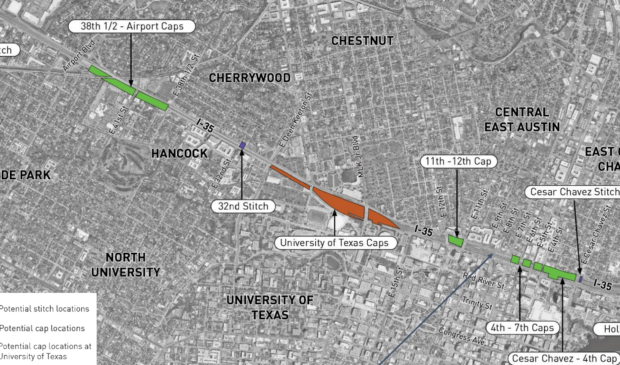Panelists discuss size, shape of downtown caps proposed for I-35 expansion
Friday, January 26, 2024 by
Chad Swiatecki Planners expect the series of multi-acre caps that will eventually cover portions of a reconstructed Interstate 35 to feature compact two- and three-story buildings that could support retail, arts spaces or limited amounts of housing to serve the downtown area. Those lower profiles could make the projects less attractive for potential developers who prefer height and density downtown, but the engineering considerations of building on top of a major freeway present some challenges that require shorter buildings.
At the recent breakfast panel held by Urban Land Institute Austin, discussion focused on the so-called cap-and-stitch components of the I-35 reconstruction, which will see the city likely commit to more than $500 million in construction of the caps as well as additional smaller east-west stitches over the roadway.
“We anticipate those will be limited to two to three stories, and the reason for that is to go any taller like four stories, six stories or eight stories, the additional construction design … you’ve got to build deeper columns, wider structures, a larger lid, you have to go deeper with the roadway,” said Richard Mendoza, director of the city’s Transportation and Public Works Department. “Those cost/benefits did not calculate out, and so for that reason, we stopped at the two to three stories.”
Mendoza said the lower-profile buildings on the caps, especially for the one proposed at 11th and 12th streets, would be in line with the community’s goals of removing the long-standing barrier to East Austin and residents who felt removed from the rest of the city.
“We are going through great expense and design to remove a barrier between downtown and the east side by taking down those elevated roadways. Why would we want to put something back that would create that additional physical barrier after all that investment?” he said.
The city is in the very beginning stages of planning and designing for the caps, some of which would not be constructed for almost a decade. Late last year, City Council approved $15 million to pay for a portion of the state’s engineering work for the caps and stitches.
Another $19 million in design expenses will need to be paid by the end of the year, which is also when the city will need to identify how it would pay for the caps – planned for Cesar Chavez Street, 11th and 12th streets, 27th Street and 38th Street to Airport Boulevard – and a handful of additional stitches.
Roughly $100 million of that could be covered by a federal grant for the Cesar Chavez cap, with city leaders expected to learn of the results of the relevant grant application in either February or March.
Emily Risinger, director of planning and design for the Downtown Austin Alliance, said the caps will be tailored to fit the character of the nearby communities while also fitting into the needs of other major infrastructure projects such as the rebuild of the Austin Convention Center, Project Connect and the enhancements of the Waterloo Greenway.
“We’re working on a scale where we’re going to have multiple caps with different flavors of amenities and different flavors of community programming that people are going to want to see, and we might even have a series of conservancies down the line to make it happen,” Risinger said.
Tommy Abrego, Mobility35 program manager for Texas Department of Transportation, said the state is committed to making the engineering needs of the city’s caps and stitches fit with the $4.5 billion reconstruction that will include all the necessary support and air quality infrastructure.
“There will continue to be a highway and live traffic underneath, so there’s obviously some safety considerations that need to be kept in mind as we move forward,” he said. “From an engineering perspective, the structural side of it, we have been and will continue to work with DAA in Austin on the loading capacity as part of the walls, the columns, the beams, the lid, that takes what’s going on top.”
The Austin Monitor’s work is made possible by donations from the community. Though our reporting covers donors from time to time, we are careful to keep business and editorial efforts separate while maintaining transparency. A complete list of donors is available here, and our code of ethics is explained here.
You're a community leader
And we’re honored you look to us for serious, in-depth news. You know a strong community needs local and dedicated watchdog reporting. We’re here for you and that won’t change. Now will you take the powerful next step and support our nonprofit news organization?








